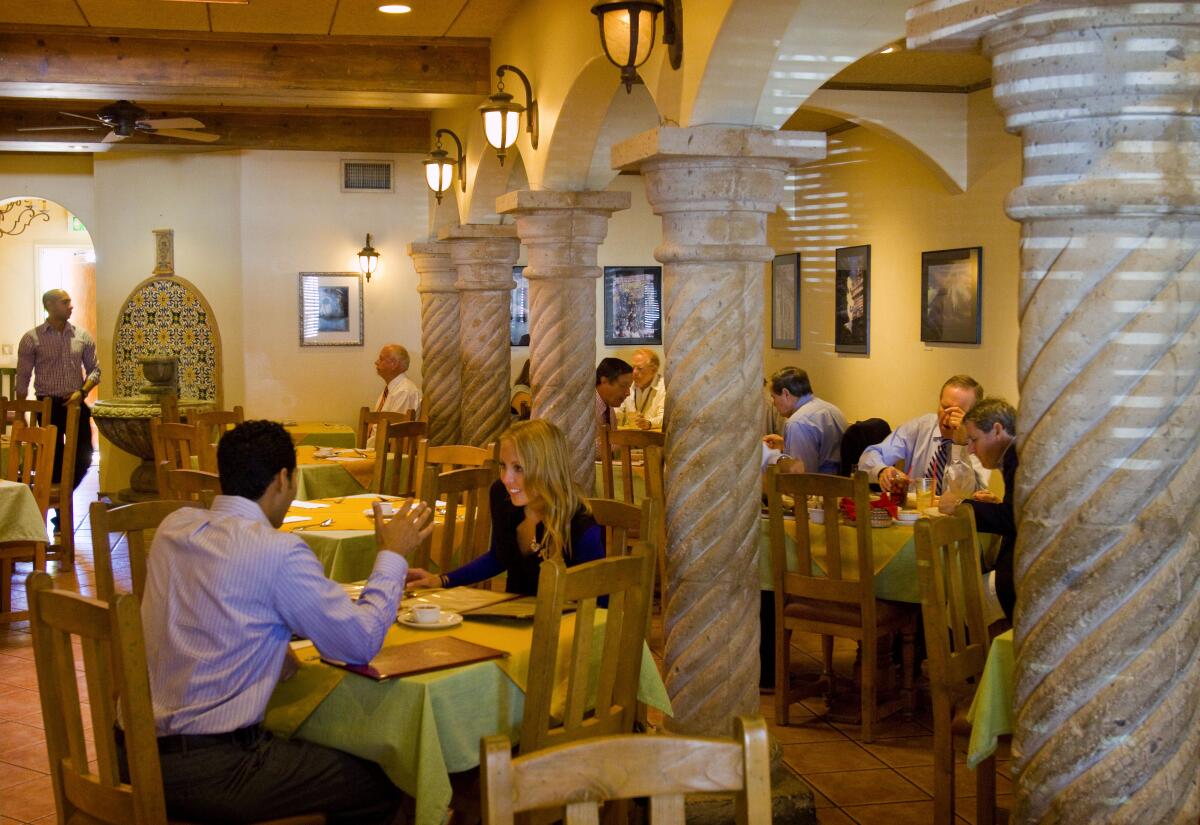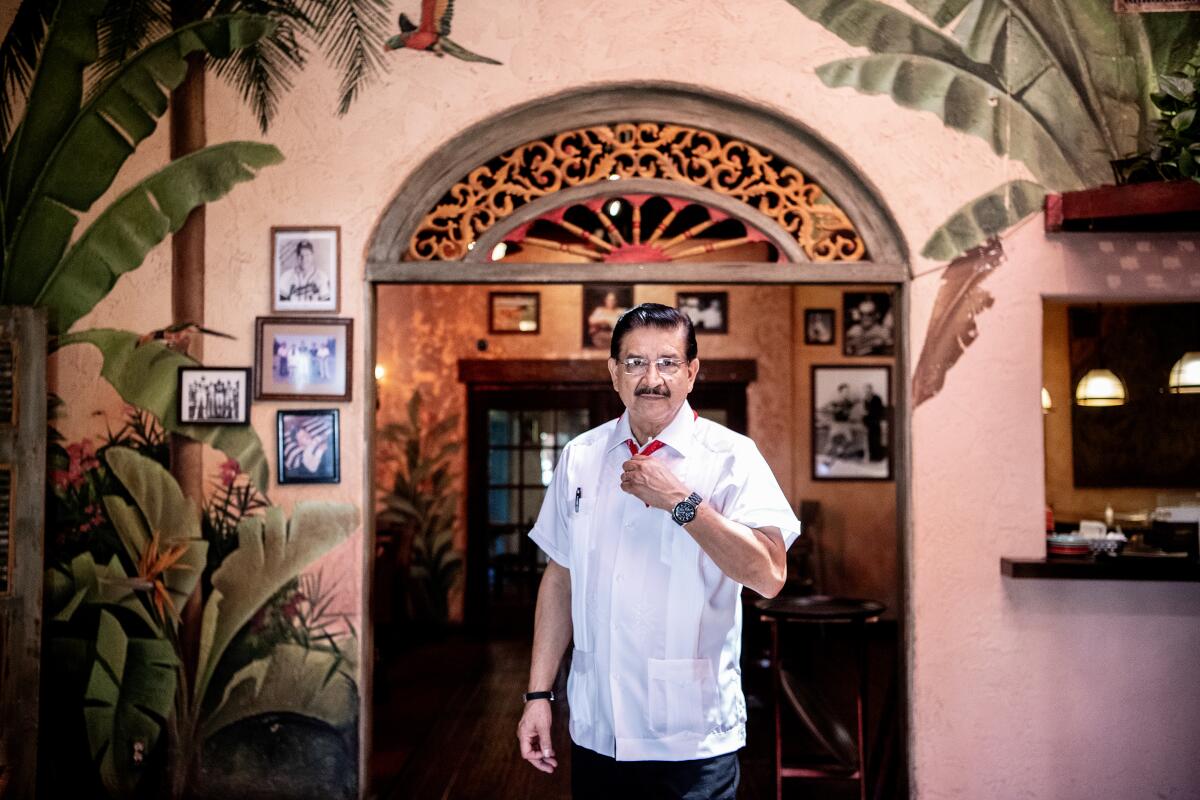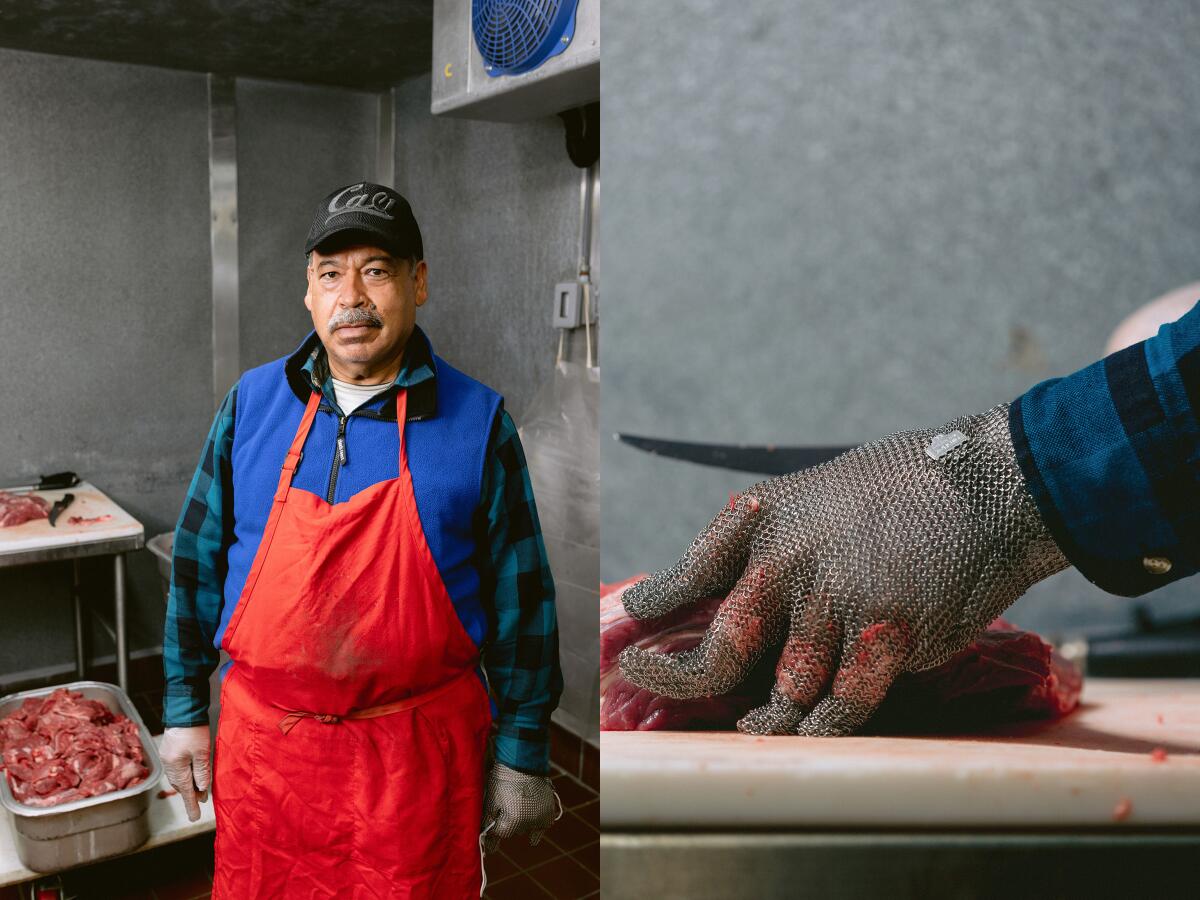The East L.A. chef who rejected the Mexican combo plate and inspired a food revolution

- Share via
I don’t think I’m alone among born-in-East L.A. Chicanas and Chicanos in my complicated relationship with Mexican food. I grew up with a grandmother who regularly made menudo and kept cactus paddles around for stewed nopales. My mother’s cooking may have been largely Americanized, but she was always charring chiles on an electric pancake griddle for salsa, which even to this day is a constant in her refrigerator; her eggs and bacon came with refried beans, enriched with fat from the fried bacon instead of lard. And once a month or so she’d cook a whole beef tongue with onions and bay leaves for our homestyle version of lengua tacos. These two women are the reason I don’t shy away from unusual flavors or textures. After years of eating and loving the food of my heritage, I became known, sometimes with revulsion by schoolmates and more recently with admiration, as an adventurous eater.
Yet when I went out to eat Mexican food during my childhood with my mom and grandmother, our choices were far from adventurous. Mexican restaurant food was most often reduced to the classic combo platter. Hard-shell tacos and enchiladas heavy with drifts of orange cheese. I didn’t mind — indeed, to my kid palate, I found comfort and even joy in the way the mellow melted cheese adhered to the rolled enchiladas covered in a sauce much milder than the salsa my mother made at home,
In college, however, I grew restless. All over California, Chinese and Italian food was expanding beyond chop suey and spaghetti with giant meatballs. Regional specialities and fine dining innovations were emerging thanks to pioneers like Cecilia Chiang at the Mandarin in San Francisco and Beverly Hills, Piero Selvaggio at Valentino in Santa Monica and Mauro Vincenti who set his Rex il Ristorante amid the Art Deco splendor of the Oviatt Building in downtown Los Angeles.
But Mexican food for the most part in those years was trapped in its guacamole comfort zone. Two white women chefs from the midwest, Mary Sue Milliken and Susan Feniger, stirred things up when they opened L.A.’s Border Grill in 1985 and served food inspired by their travels in Mexico, including sauteed squid, veal tongue stew and black bean-filled huaraches. Meanwhile, the British cookbook author Diana Kennedy was revealing the depth of Mexican regional cuisine for home cooks. But as I wrote in a 1991 story for this paper, “Waiting for the Revolution,” the transformational change in opening people’s minds to the possibilities of Mexican cuisine in Los Angeles would need to be fought by Mexican chefs.
Thirty years later, we have transcendent tasting menus from Carlos Salgado at Costa Mesa’s Taco Maria, Gilberto Centina’s magnificent seafood spot Holbox and his Yucatecan specialty place Chichen Itza in downtown L.A., the Oaxacan mole masters at the Lopez family’s Guelaguetza in Koreatown, Wes Avilia’s Hollywood-lush fish restaurant Ka’teen and Jaime Martin del Campo and Ramiro Arvizu’s La Casita Mexicana in Bell, not to mention — among countless other regional places — the seasonally driven Arts District hot spot Damian opened by Enrique Olvera, whose Mexico City restaurant Pujol ranked ninth on the World’s 50 Best Restaurants list in 2021.
However, to my mind, little of this would have happened without the late Jose Hernandez Rodriguez, chef and owner of the original La Serenata de Garibaldi in Boyle Heights. After Rodriguez’s 2010 death, L.A. City Councilman Gil Cedillo called the chef the “maestro de salsas” — and it’s true, Serenata’s sauces, usually draped over fish, were famous. An orange-hued sauce of cascabel, arbol and habanero chiles. A red and a green pipian sauce. In her 1989 review of the restaurant, Barbara Hansen wrote that he named one sauce of tomatoes, cream and green chiles Golla, for Gregoria Golla, “who once had a little food stand in Torreon, Coahuila, where Rodriguez was born.” I remember a bright, chile-spiked cilantro sauce.
Rodriguez’s rotating repertoire of more than 60 sauces attracted diners from all over Southern California, including Hollywood and the Westside. People used to boast how they’d gone “all the way to Boyle Heights” for dinner at Serenata, just a five-minute drive from downtown L.A. and with a gated parking lot for the Mercedes and Jaguar drivers.
Rodriguez didn’t have a lot of patience for the state of Mexican cooking in Los Angeles and was on a mission to open people’s minds.
“I think what we have to do is introduce real Mexican food,, to present Mexican food with dignity and pride — and also, to educate the people,” he told me in 1991. “In my opinion, the political and social conditions that existed 100 years ago — and I’m talking about racism — contributed to the creation of California-Mexican food.
“Mexican cooking had to please the American people, and in those years, they didn’t appreciate spicy-hot sauces,” he continued. “In trying to give Americans what they wanted, Mexican cooks started making sauces on the sweet side. ... What you have are a lot of big, beautiful buildings with terrible food.”
This way of thinking led some in the neighborhood to call him an elitist and they said his food wasn’t truly Mexican.
“When people suggest that, I say, ‘Why not?’” he responded. “First of all, I am Mexican. Secondly, we use ingredients that are used in every kitchen in Mexican cooking. Chile serrano is not from Poland or from France. It’s Mexican. If French chefs can develop nouvelle cuisine and Italian chefs too, why not Mexican chefs?”
Enjoying this newsletter? Consider subscribing to the Los Angeles Times
Your support helps us deliver the news that matters most. Become a subscriber.
You can still get shrimp with cilantro sauce or salmon with red pipian sauce at Serenata’s remaining Westside location on Pico Boulevard, but these days many customers seem to go for the fajitas instead. Now that we have witnessed the evolution of Mexican cooking in Los Angeles and are no longer surprised at what is possible, we can look back on our combo-plate roots and appreciate the familiar tastes many of us here grew up on. The roots of classic Mexican American cuisine may be entangled in colonialism, but generations of Latino cooks and servers have worked at Cal-Mex restaurants and helped shape them into welcoming gathering spots for friends and family.

With this in mind, the food staff’s Bill Addison, Lucas Kwan Peterson, Stephanie Breijo, Jenn Harris and columnist Gustavo Arellano put together a guide to Los Angeles’ 38 essential classic Mexican restaurants. At one point, Peterson had a list of more than 100 restaurants that could have gone on the list. After discussions with food editor Daniel Hernandez — and a lot of eating — the list was whittled down to 38 key places. Arellano, who happens to be the author of “Taco USA: How Mexican Food Conquered America,” wrote about his youthful “smug, stupid dismissal” of Cal-Mex food and what changed his mind. Peterson spent time with five longtime El Cholo employees — all in the “20 year club” — who collectively have more than 200 years of service at the chain. And Harris got a behind-the-scenes look at the making of Tito’s Tacos famous deep-fried tacos, starting at 3:30 in the morning. On a busy day, Harris says, Tito’s fries up to 8,000 tacos. I love that Peterson and Harris give voice to restaurant workers who may not be famous but are crucial to feeding this city.

Eat your way across L.A.
Get our weekly Tasting Notes newsletter for reviews, news and more.
You may occasionally receive promotional content from the Los Angeles Times.
The $10,000 Instagram post
“It’s a phenomenon that’s causing a paradigm shift in the restaurant world, transferring the power of influence from traditional media to anyone with a cellphone and a love for food.” In her story on the world of food influencers, Jenn Harris examined the social media effect that even a Van Nuys mariscos stand can experience — is it worth paying thousands of dollars for a TikTok post? Some say yes. What do restaurant critics think? Harris asked. She also broke down how to tell the difference between a journalist and a food influencer.
Have a question?
The day after at Roscoe’s
“After the initial shock of hearing that a hip-hop artist had been shot inside a restaurant in L.A., my mind turned to the cooks and servers who may have witnessed the violence and who would likely be hoping they wouldn’t lose precious work hours in its aftermath,” wrote food editor Daniel Hernandez one day after the shooting death of rapper PnB Rock at the Roscoe’s House of Chicken & Waffles on West Manchester Avenue. There had been a lot of talk on social media that Rock (whose real name was Rakim Allen) should have “known better” than, as Hernandez wrote, “to eat at a restaurant in a community that is harshly referred to as ‘dangerous.’” I had a feeling that if Hernandez had a meal at Roscoe’s and saw the restaurant through the eyes of its workers and customers, he’d come back with a nuanced story. His beautifully written story is worth your time.
Bub and Grandma’s rises
Stephanie Breijo’s restaurant news column has the happy news that the L.A. bakery Bub and Grandma’s — which nearly always runs out of bread at the Hollywood Farmers Market — is opening a full restaurant.
— Jenn Harris ate a lot of good sandwiches last week. Among them: jerk-style Italian beef at Bernie’s Soul Kitchen, Mr. T’s croquette monsieur and the egg salad sando at the new Culver City location of Katsu.
Food Bowl this week
L.A. Times Food Bowl is in full swing. Among the events coming up are Mujeres del Maguey, a four-course collaboration presented on Sunday by Re: Her between Corissa Hernandez of Nativo in Highland Park and Todo Verde’s chef Jocelyn Ramirez with pairings of mezcal and other agave spirits. Also, coming on Sept. 22 is a nine-course collaboration between chef Kevin Lee, better known on social media as @chefboylee and Kinn’s chef Ki Kim. And tickets are still available for our L.A. Times Night Market, Sept. 23-25, which kicks off with a “Smoked Soirée,” featuring a BBQ demo by pitmaster Kevin Bludso, a burger battle judged by Amboy’s Alvin Cailan and hosted by Eric Greenspan, plus an Italian beef demo with “The Bear’s” Matty Matheson and Courtney Storer, the culinary producer who made sure the show’s beef sandwich stayed true to its Chicago roots. Find the full schedule of Food Bowl events, presented by City National Bank, at lafoodbowl.com.
Eat your way across L.A.
Get our weekly Tasting Notes newsletter for reviews, news and more.
You may occasionally receive promotional content from the Los Angeles Times.




